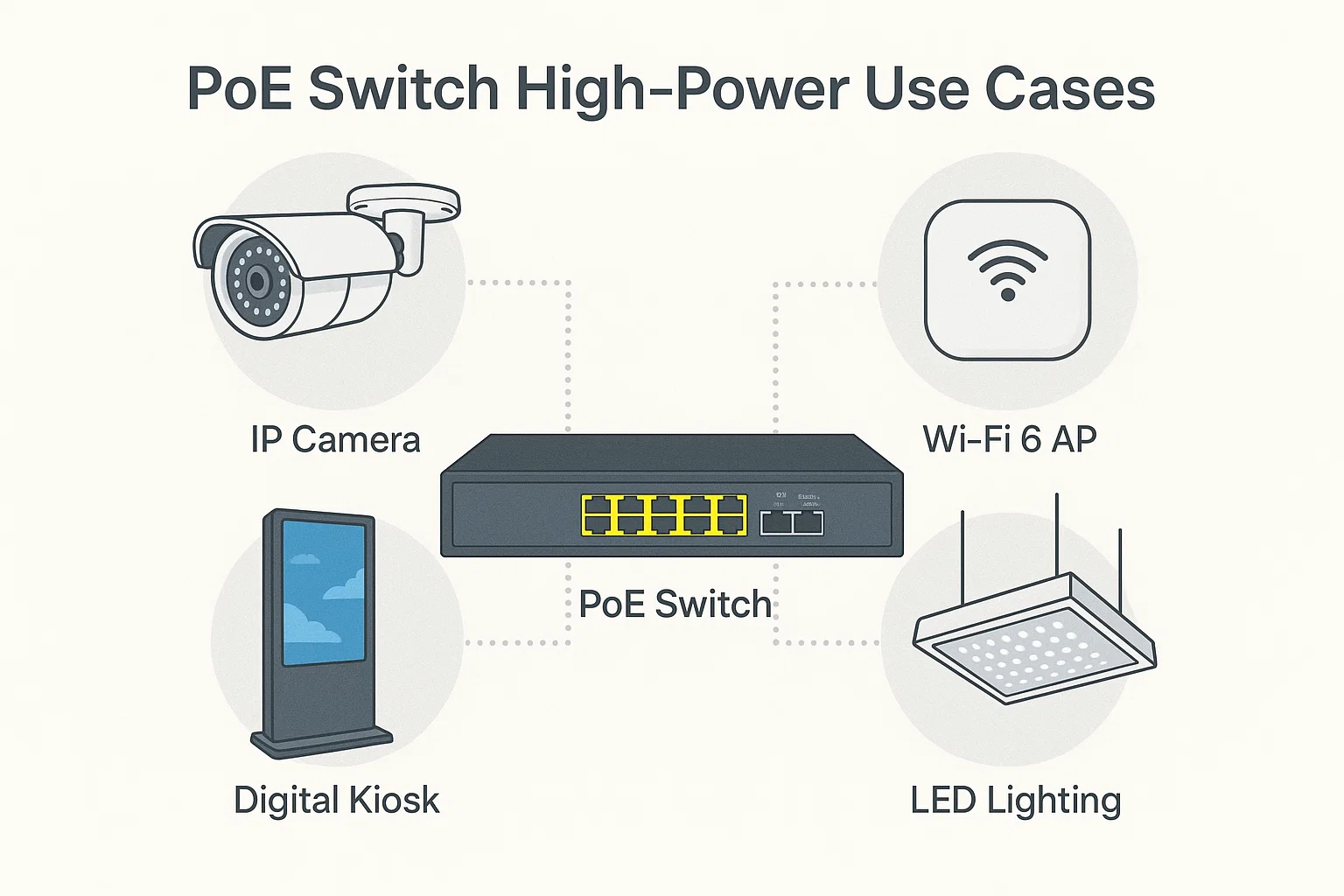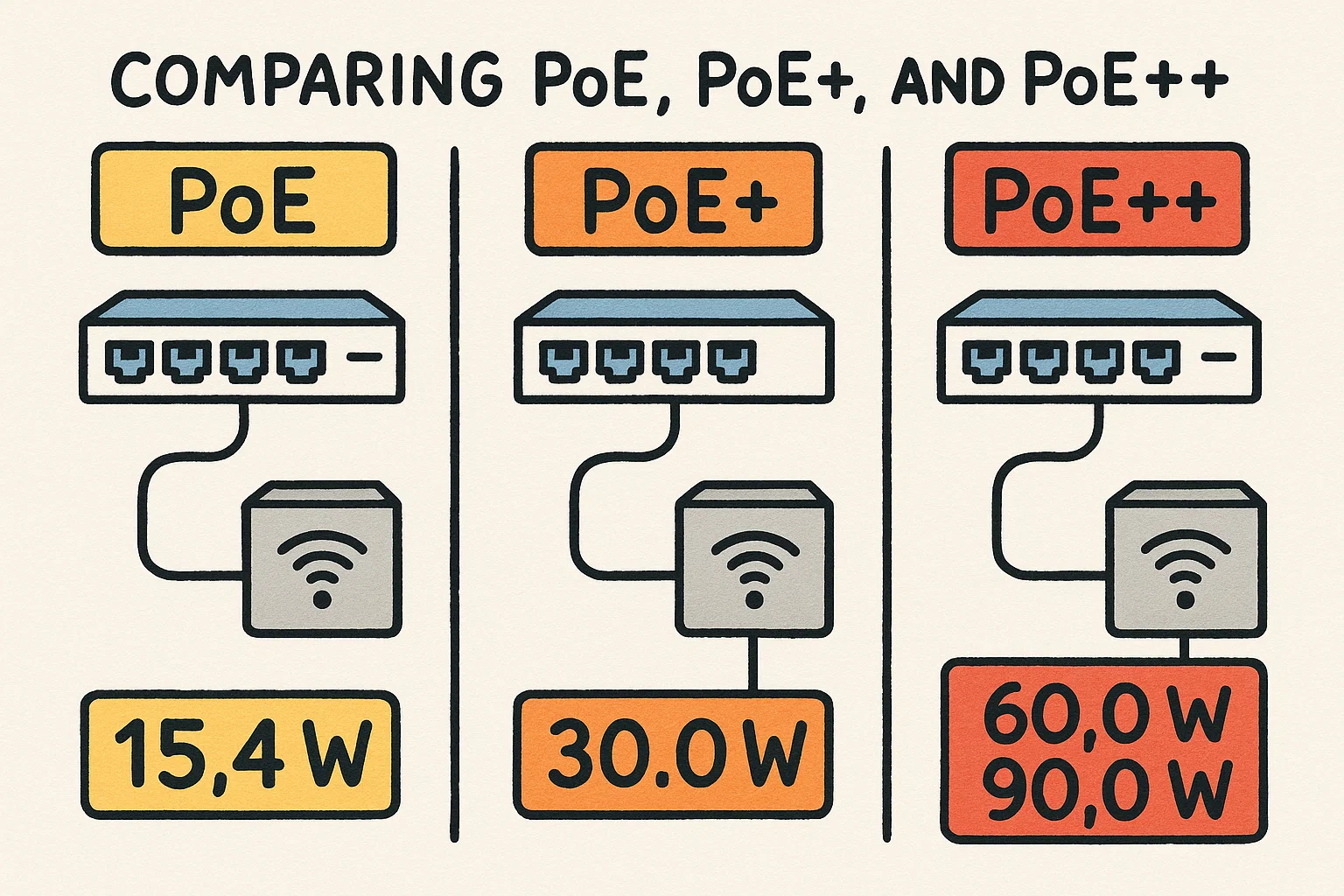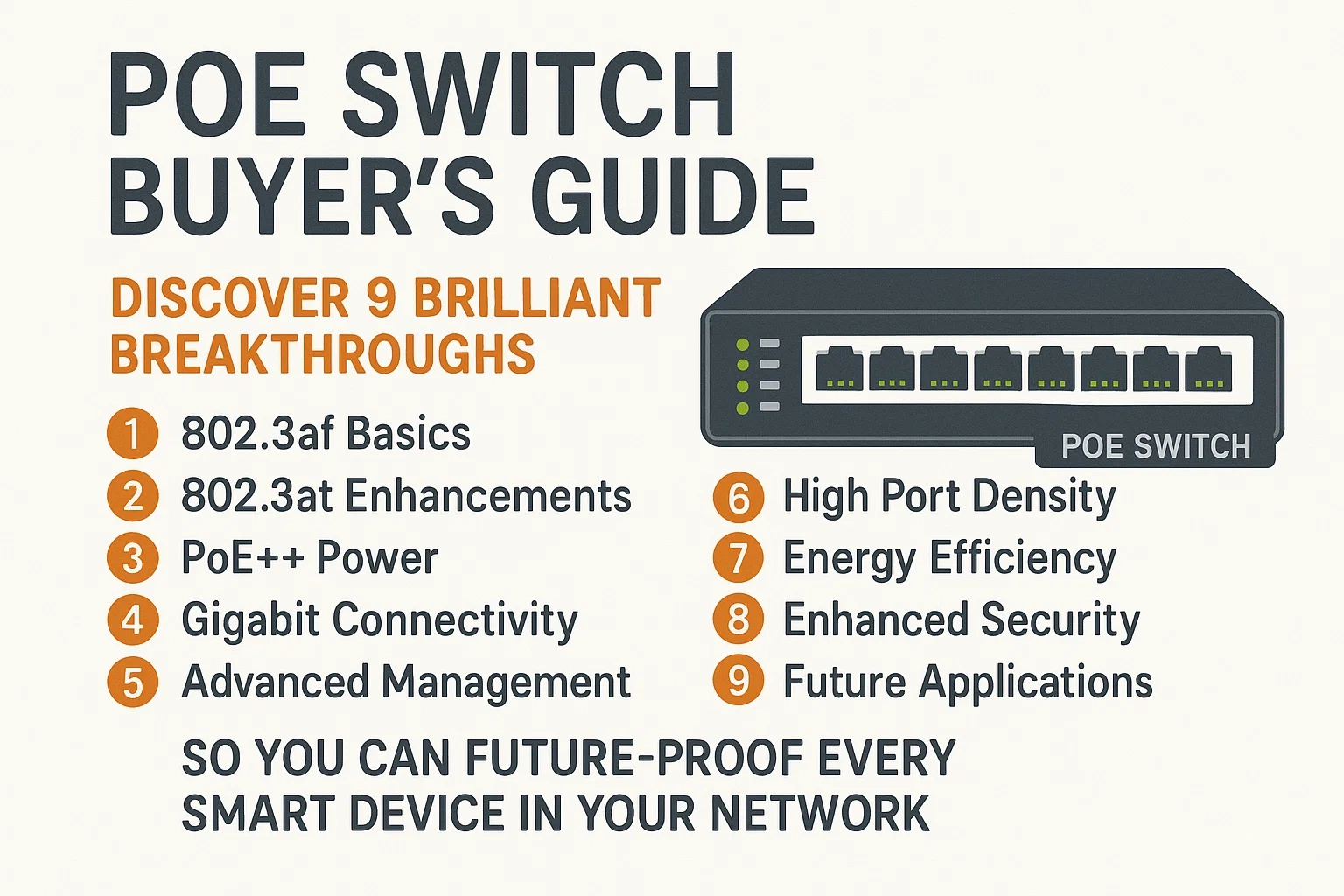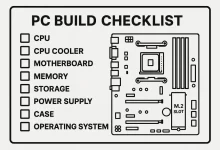Introduction
Picture this: I’m dangling off a ladder at 2 a.m., trying to finish a last-minute security-camera install. Power outlets? None. All I had was a single Cat 6 drop and a trusty PoE switch humming in the rack. One cable—data plus juice—and I was done. That “aha!” moment sold me on power over Ethernet for life.
From 2003 to Today—The PoE Timeline
The IEEE 802.3af standard officially blessed PoE back in 2003, giving us 15.4 W per port and kicking off two decades of innovation. Demand skyrocketed, so 802.3at (PoE+) doubled the output to 30 W. Fast-forward to the modern 802.3bt era—better known as PoE++—and we’re talking up to 100 W per port for Type 4 devices, enough to run laptops, PTZ cameras, even LED lighting grids.

Spec-to-Spec Showdown: PoE vs PoE+ vs PoE++
| Type | Standard | Max Power/Port | Twisted Pairs | Typical Devices |
|---|---|---|---|---|
| Type 1 | IEEE 802.3af | 15.4 W | 2 | VoIP phones, basic IP cams |
| Type 2 | IEEE 802.3at | 30 W | 2 | Multiband WAPs, PTZ cams |
| Type 3 | IEEE 802.3bt | 60 W | 4 | Video conference bars, thin clients |
| Type 4 | IEEE 802.3bt | 100 W | 4 | Laptops, LED panels |

Standard PoE (Type 1) — The 15.4 W Classic
Think of a basic PoE switch as the trusty first car you drove in college—simple, reliable, but not winning any drag races. With 15.4 W on tap, it feeds everyday devices like wall-mounted VoIP phones, occupancy sensors, and fixed IP cameras. Pros? Dirt-cheap cable runs and rock-solid compatibility. Cons? Anything motor-driven or motorized—like a PTZ camera—will yawn at that power budget.
PoE+ (Type 2) — The 30 W Workhorse
Need more oomph? Enter PoE+. The jump to 30 W lets a PoE switch power beefier wireless APs that pack multiple antennas, or a fan-less mini-PC perched behind a digital sign. According to the PDF’s advantages list, PoE+ remains backward-compatible with Type 1 endpoints while nudging you toward Cat 5e or better cabling for peak efficiency.
PoE++ (Type 3 & 4) — High-Power Heavyweight
This is where the gloves come off. Type 3 pours out up to 60 W, and Type 4 cranks it to a jaw-dropping 100 W. That means your PoE switch can now drive a conference-room soundbar, an all-in-one thin-client monitor, or even charge a lightweight ultrabook. The spec achieves this by energizing all four copper pairs, spreading current to keep thermal rise in check.
Hi-PoE & Future-Proofing
Several vendors market “Hi-PoE” gear—basically Type 4 implementations with proprietary tweaks for POS kiosks or stadium lighting. They’re backwards-compatible, but you’ll want Cat 6A cabling to avoid voltage drop over long runs. At the bleeding edge, research teams are toying with 200 W bids, though that’s still lab-coat territory.
How to Choose the Right PoE Switch
- Power Budget Math: Sum the wattage of every endpoint, then add 20 % headroom. A 24-port PoE switch rated at 370 W may throttle if you hook up twenty-four 30 W APs.
- Cable Quality: Cat 5e is okay for Type 2. For Type 4, spring for Cat 6A or you’ll waste heat, not watts.
- Smart Features: Look for per-port power metering, LLDP-MED negotiation, and web or API control.
- Stacking & Uplinks: A fully loaded PoE++ stack demands 10 GbE or fiber uplinks to keep data flowing as fast as power.
For a deeper dive into memory bottlenecks that can crop up when backhauling multi-gig links, check out our DDR5 vs DDR4 performance guide. And if you’re pairing GPUs over the same copper fabric, the new Intel Arc Pro workstation review is a must-read.
Case Study: My Smart-Office Upgrade
I recently migrated a 5-room coworking space. We ditched 16 wall-warts, swapped in an 8-port PoE++ PoE switch, and fed it with a compact UPS. The result? Zero cable clutter, 40 % faster install time, and happier tenants who can roam between conference rooms without losing Wi-Fi 6E throughput.
Installation Tips & Gotchas
- Always verify polarity: modern PoE switch ports auto-negotiate, but passive injectors can fry gear.
- Break large deployments into redundant PoE stacks to avoid a single-point power failure.
- Use shielded keystone jacks in noisy industrial settings to keep EMI from throttling data.
- Firmware counts—update regularly to patch LLDP quirks.
Buying Guide Checklist
# show power-inline: CLI command every admin should memorize. It tells you, per port, how many milliwatts the PoE switch is coughing up. If you’re close to rated max, time to scale out.
| Feature | Must-Have | Nice-to-Have |
|---|---|---|
| Total Budget | >= 370 W for 24-port | Expandable PSU |
| Port Speed | 1 GbE | Multi-Gig / 10 GbE |
| Management | Web/CLI | RESTful API, SNMP v3 |
| Security | 802.1X, ACLs | Dynamic VLAN + DHCP snooping |
FAQ
Q: Can a Type 4 port damage a Type 1 device?
A: Nope. The negotiation handshake locks voltage at the level the device requests.
Q: Do I really need Cat 6A for PoE++?
A: For runs over 55 m, yes. Otherwise copper resistance steals your watts.
Q: Where can I see live deployment examples?
A: Cisco maintains an extensive reference design library for PoE smart buildings—perfect research material. Check it out here.
Q: Where do the standards live?
A: All official specs are archived at IEEE. Grab the 802.3bt PDF if you love fine print.
Final Thoughts
Whether you’re powering two webcams or a floor of conference rooms, choosing the right PoE switch is the secret sauce that keeps both data and electrons flowing. Start with an honest watt-budget, pick cabling that matches, and you’ll have a network that just works—no midnight ladder acrobatics required.

 FoxDoo Technology
FoxDoo Technology








